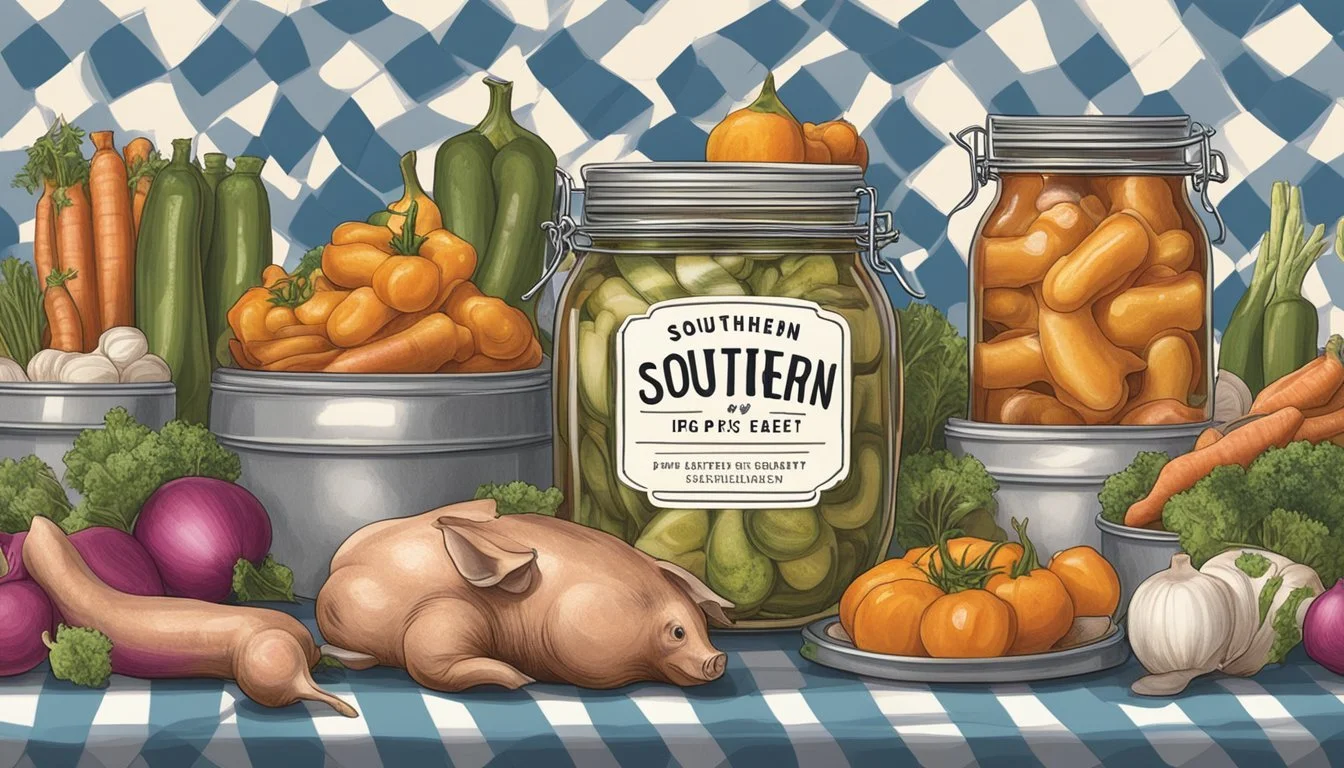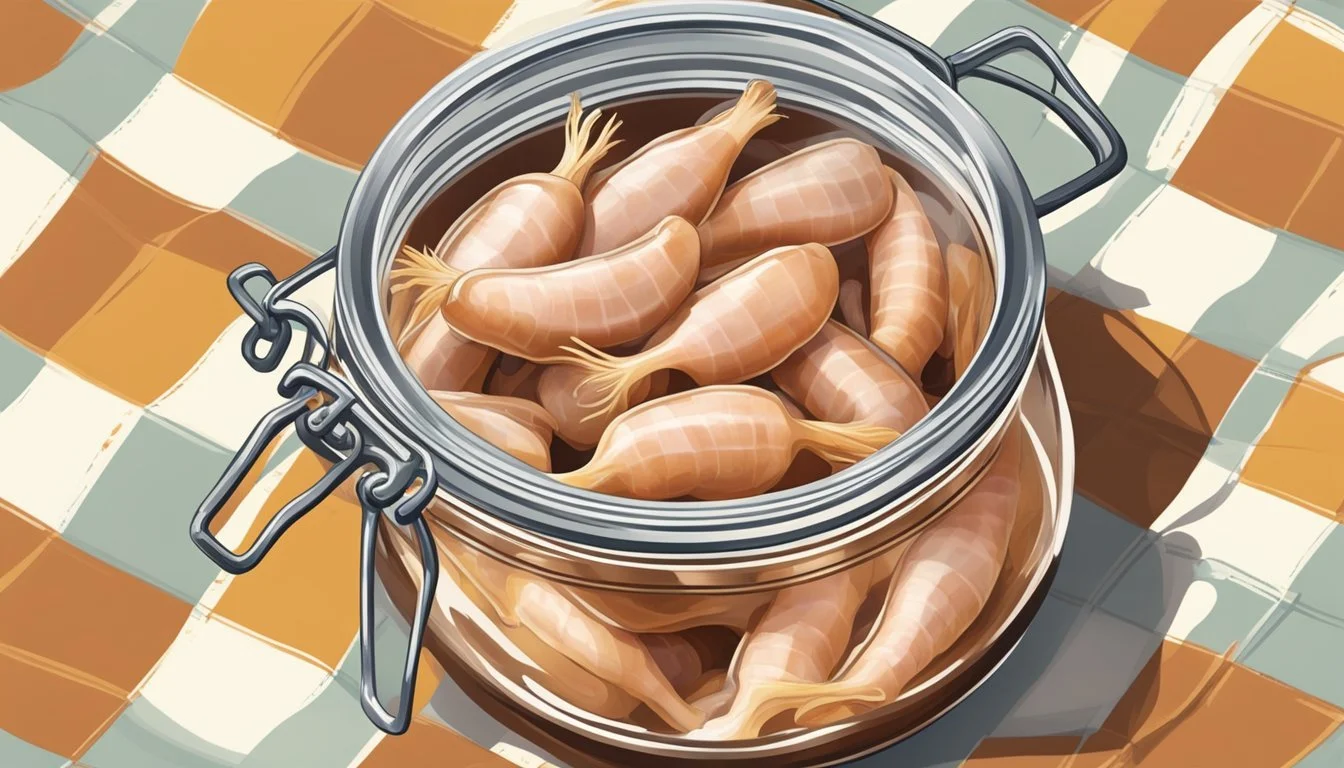Pickled Pig's Feet
Unwrapping the Southern Delight with Tangy Appeal
Pickled pig's feet are a traditional Southern U.S. delicacy that embodies a rich cultural heritage with its roots deeply embedded in the region's culinary history. This distinctive dish is prepared by pickling the feet of pigs in a brine solution, which creates a tangy and savory flavor profile. The practice of pickling meat, including pig's feet, has been a time-tested method of preservation, allowing these cuts that might otherwise be wasted to be enjoyed throughout the year.
In the South, pickled pig's feet are more than just a food item; they are a symbol of resilience and resourcefulness. The recipe varies from one place to another, but commonly includes a combination of vinegar, salt, and an assortment of spices such as peppercorns, bay leaves, and cloves to add complexity to the tanginess of the dish. The pickling process not only imparts a tangy twist to the meat but also renders the feet tender, making them a unique addition to a variety of meals or enjoyed on their own as a flavorful snack.
History and Cultural Significance
The history and cultural significance of pickled pig's feet are deeply embedded in Southern cuisine, reflecting the region's ingenuity in food preservation and its commitment to utilizing every part of the animal. This section delves into the food's origins in Southern cooking, its place within soul food traditions, and the pickling techniques that have been honed over time.
Origins of Pickled Pig's Feet in Southern Cuisine
Southern United States: The tradition of eating pickled pig's feet in the Southern United States can be traced back to European influence, where the practice of pickling meats was a necessity for food preservation. Embraced by Southern cooks, this method became a fixture in the culinary landscape, especially in states like Louisiana and Mississippi, where pig's feet are savored for their tang and texture.
Historical Context: The need to use every part of the animal and reduce waste led to the inclusion of pig's feet in Southern meals. This not only speaks to the resourcefulness of past generations but also to a broader historical context where food preservation was crucial for sustenance.
Pig’s Feet as Soul Food
Soul Food: Pig's feet became an important element in the diverse tapestry of soul food—a cuisine that originated from the African American community, particularly from the culinary traditions of enslaved people in the South. Serving as a powerful emblem of heritage, pig's feet are revered for their rich flavor and cultural resonance.
Enslaved Communities: Enslaved Africans in the South would often receive the less desirable cuts of meat, including pig's feet, from their oppressors. These communities exercised culinary creativity to transform such cuts into delectable dishes, thus reinforcing the significance of pig's feet within soul food.
Evolution of Pickling Techniques
Pickling: The technique of pickling pig's feet involves a brine solution often enhanced with vinegar, salt, and various spices, which not only imparts a distinctive tang but also acts as a preservative. Over the years, this technique has evolved, with different regions introducing their unique twists to the brine mixture.
Preservation: The evolution of pickling techniques was driven by necessity, as people sought methods to preserve food before the advent of modern refrigeration. The acid in the pickling solution prevents the growth of bacteria, allowing the preserved pig's feet to be stored for extended periods.
Nutritional Profile and Health Considerations
In discussing the nutritional profile and health considerations of pickled pig's feet, it's critical to address the benefits provided by gelatin and collagen, the caloric content, and the importance of USDA inspection to ensure food safety.
Benefits of Gelatin and Collagen
Pickled pig's feet are rich sources of gelatin and collagen—two proteins that contribute significantly to skin health. Collagen promotes skin elasticity and may aid in decreasing the signs of aging. Gelatin, which is a product of collagen breakdown, has been associated with joint health and may support the body's wound healing process due to its amino acid content.
Caloric Content and Dietary Impacts
A serving of pickled pig's feet is relatively low in calories, making it an option for those practicing calorie control. However, as with any food, moderation is key because pickled pig's feet can also be high in sodium.
Calories: Estimated at 100-200 per serving
Key Note: High sodium content calls for moderate consumption
USDA Inspection and Food Safety
Pickled pig's feet, when sourced from a reputable supplier, undergoes USDA inspection to ensure they meet safety standards. Consumers should look for a USDA inspected seal to ensure the pig's feet have been processed following stringent hygiene and safety protocols. This step is crucial to mitigate the risk of foodborne illnesses and guarantee the product's quality.
USDA Seal: An indicator of food safety and protocol adherence
Hygiene Standards: Ensures prevention of contamination
Preparation Techniques
In the realm of Southern cuisine, pickled pig's feet are considered a delicacy, requiring meticulous preparation techniques that are crucial for achieving the right flavor and tenderness.
Cleaning and Prepping Pig's Feet
Before one begins the cooking process, it is imperative to thoroughly clean the pig's feet. This involves rinsing them under cold running water and scraping away any remaining hairs. Some cooks also recommend briefly blanching the feet in boiling water to ensure cleanliness and ease further preparation.
Traditional Boiling and Braising Methods
The next step employs the traditional boiling method. One must submerge the pig's feet in a pot of water and bring to a boil, then reduce to a simmer. This process typically lasts several hours until the feet are tender. Following this, a braising technique can be used, where the feet are cooked with a combination of vegetables, vinegar, and spices to infuse flavor before pickling.
Alternative Cooking Methods
While boiling is the most conventional method, alternative cooking techniques such as pressure cooking may also be used to reduce cooking time while still ensuring that the feet are properly tenderized.
Seasoning and Flavoring
Precise seasoning is critical for the distinctive taste of pickled pig's feet. The seasoning blend often contains elements like peppercorns, bay leaves, garlic, and various other spices that complement the pickling process. The feet are then combined with a vinegar-based pickling solution, which may include sugar and other flavorings, to achieve the balance of savory and tangy that characterizes the dish.
The Pickling Process
The art of pickling transforms the humble pig's foot into a savory, tangy treat. The process involves a careful balance of vinegar, salt, and spices in a brine that preserves and flavors the feet over time.
Creating the Pickling Brine
To create the brine, one must dissolve salt and sugar in boiling water, then cool this mixture. This brine forms the base into which vinegar and a tailored selection of spices are added to enhance the flavor.
Ingredients for Brine:
Water
Salt
Sugar
The Role of Vinegar and Spices
Vinegar is the acidic component that acts as a preservative, giving pickled pig's feet their characteristic tangy taste. Spices, such as peppercorns, bay leaves, and cloves, are added to the vinegar to infuse the brine and the meat with complex flavors.
Commonly Used Spices:
Peppercorns
Bay leaves
Cloves
Mustard seeds
Duration and Storage Techniques
The pig's feet should remain submerged in the brine for a period that ensures adequate preservation and flavor infusion, usually several days to weeks. Proper storage in a cool, dark place can make pickled pig's feet last longer, retaining their desired taste and texture.
Storage Recommendations:
Submerge pig's feet completely in brine
Store in a cool, dark place
Seal in airtight containers
By adhering to these techniques, one ensures the creation of a pickled variety that stands the test of time, delivering the treasured Southern flavor to those who seek a taste of tradition.
Tasting and Serving Suggestions
Pickled pig's feet are known for their distinctive tangy flavor and tender but somewhat gelatinous texture, which might be an acquired taste for some. They are traditionally savored as both an appetizer and a side dish in the Southern United States.
Appreciating the Acquired Taste
For those new to pickled pig's feet, it's important to understand that they possess a bold, tangy flavor that may take some getting used to. The key to appreciating this delicacy is starting with a small portion and allowing the palate to adjust to the unique taste profile, which is typically savory and slightly tangy.
Pairings with Other Southern Dishes
Pickled pig's feet complement several Southern classics. Possible pairings include:
Greens: Such as collard greens or mustard greens, which balance the tanginess with their earthy flavor.
Starches: Staple sides like macaroni and cheese provide a creamy contrast to the pickled tang.
Cornbread: A slice of warm cornbread acts as a perfect vessel for the pickled meat, absorbing its juices.
Presentation and Garnishing Tips
When serving pickled pig's feet, presentation can greatly enhance the experience. To keep it visually appealing and add a punch of flavor, consider these garnishes:
Parsley or Chives: Sprinkle finely chopped fresh herbs for a pop of color and freshness.
Sliced Onion: A few rings of red onion offer a crisp texture and a vibrant look.
Peppers: Sliced pickled peppers can heighten the experience by adding another layer of tanginess and a bit of heat.
Offering pickled pig's feet on a platter with an assortment of these sides and garnishes allows guests to customize their experience based on their own taste preferences.
Culinary Variations and Modern Adaptations
Pickled pig's feet have evolved from a traditional Southern delicacy to a dish with a variety of modern twists and international influences. This transformation reflects changes in preparation techniques and flavor profiles, appealing to a wider audience while still honoring its roots.
Regional Twists on the Classic Recipe
In the Southern United States, pickled pig's feet are a testament to the region's commitment to nose-to-tail eating. This time-honored practice uses every part of the animal to minimize waste. However, each area has its unique take on the dish. While some may adhere to traditional recipes featuring a straightforward brine with vinegar, onions, and local spices, others incorporate regional ingredients like smoked paprika or barbecued flavor profiles to enhance the taste. These local variations not only add depth to the dish but also reflect the culinary diversity found within Southern cuisine.
Contemporary Interpretations
Chefs across the nation are reimagining this Southern staple by experimenting with cooking techniques and flavors. A modern interpretation might involve baking the pig's feet to crisp the skin before pickling, adding a textural contrast to the tangy brine. Additionally, contemporary adaptations often pair the tanginess of the pickled meat with sweet and spicy elements, such as adding honey or chili flakes to the pickling solution. This modern approach broadens the appeal and transforms the pickled pig's feet into a versatile main dish that can stand alone or complement other Southern-inspired sides.
Fusion Dishes and International Influence
International culinary traditions have introduced new ways to enjoy pickled pig's feet. For instance, jokbal, a popular Korean dish, features braised pig's feet with soy sauce and spices, served with a side of fermented shrimp sauce. Fusion dishes may adopt this method but finish the feet with a pickling process to merge the savory, umami-rich Korean flavors with the traditional tang of Southern pickling techniques. Through such innovative combinations, pickled pig's feet continue to be a dynamic element on global menus, showcasing the dish's ability to transcend cultural boundaries while still paying homage to its Southern roots.
Where to Find Pickled Pig's Feet
Pickled pig's feet, a traditional Southern U.S. delicacy, can be readily found across various outlets for enthusiasts looking to indulge in their tangy flavor.
Specialty Stores and Regional Availability
In the Southern United States, shoppers keen on tasting this unique item may find pickled pig's feet at local specialty stores. These locations often celebrate regional cuisine and thus stock such traditional fare. Availability can sometimes extend to larger grocery store chains in areas where there is a demand for Southern delicacies, including retailers like Hormel, known for its wide range of preserved and cured meats.
Online Marketplaces and Grocers
For those not located in the South or unable to find pickled pig's feet in nearby stores, online marketplaces offer a convenient alternative. E-commerce platforms like eBay host a variety of sellers where consumers can purchase this product. Additionally, specialty food websites are also reliable sources, ensuring that pickled pig's feet are just a click away.
Diners and Restaurants Serving the Delicacy
Patrons interested in sampling pickled pig's feet prepared by culinary professionals may find them on the menus of some diners and restaurants. These eateries, particularly those that emphasize Southern cuisine, may offer the delicacy as a standalone dish or as a component of a larger meal. Restaurants and diners are perfect for first-timers seeking to experience the dish in its full culinary context.
Making Pickled Pig's Feet at Home
Perfecting the art of pickling pig's feet at home requires patience and a willingness to follow precise steps to ensure a delicious, safe-to-eat Southern delicacy with a tangy twist. This traditional dish involves a process of cooking and then pickling, which not only preserves the meat but also adds a unique flavor profile.
Step-by-Step Instructions
Preparation of Pig's Feet
Clean the pig's feet thoroughly, ensuring all dirt and debris are removed.
Place the cleaned feet into a large pot and add enough water to completely cover them.
Cooking Process
Bring the water to a boil over medium heat.
Once boiling, reduce the heat to low and let the pig's feet simmer until they become tender, which typically takes several hours.
Preparing the Pickling Solution
Combine one gallon of white vinegar with key ingredients like salt and spices.
Include aromatic components such as a whole onion to infuse flavor into the vinegar blend.
For an optional twist, one can add bacon to the solution for an added smoky taste.
Bring the solution to a boil, then allow it to simmer for approximately 30 minutes.
Pickling the Feet
Once the pig's feet are cooked and tenders, commonly referred to as a trotter, and the pickling solution is ready, remove the feet from the stove.
Transfer the trotters into jars.
Pour the hot pickling solution over the pig's feet in the jars, ensuring they are completely submerged.
Sealing and Storage
Seal the jars tightly and let them cool to room temperature before transferring to the refrigerator.
Store the jars in the refrigerator for at least three days to one week before consuming to allow the flavors to develop fully.
Safety Guidelines for Home Pickling
Sterilization: Ensure all jars and lids used for pickling are sterilized to prevent contamination and spoilage.
Temperature Control: Maintain appropriate cooking and pickling temperatures to ensure the pig's feet are properly preserved.
Refrigeration: Always refrigerate the pickled pig's feet during the curing period to inhibit bacterial growth.
Experimenting with Flavors and Techniques
Flavor Variations: Home chefs are encouraged to experiment with different spices and aromatics to personalize their pickled pig's feet.
Texture Adjustments: The cooking time of the pig's feet before pickling affects the final texture; less time for a firmer bite, more time for a softer texture.
Technique Tweaking: Adjusting the ratio of vinegar to water or experimenting with the addition of sweeteners like sugar can dramatically alter the final taste.
Consumption and Etiquette
Pickled pig's feet, a traditional Southern U.S. delicacy, offers a unique blend of tanginess and tenderness. When consumed appropriately and with proper etiquette, they provide a culturally rich culinary experience.
How to Consume Pickled Pig's Feet
Pickled pig's feet, also known as trotters, can be eaten cold or at room temperature directly from the jar. They are typically served as an appetizer or snack. The consumer can use their hands or a fork to hold the trotter while biting off the tender meat. Bones should be handled delicately and placed on a separate plate once the meat has been consumed.
Steps to consume:
Select a piece from the jar using a clean fork.
If served on a plate, hold the trotter securely.
Nibble the meat around the bones, enjoying the tangy flavor.
Discard the bones neatly.
Etiquette and Table Manners
When enjoying pickled pig's feet, proper table manners should be observed, especially in a social or family setting. The meat should be eaten neatly, and discarded bones should not be left on the plate or table. It is polite to use serving utensils when taking trotters from a shared container.
Important etiquette points:
Always use serving tools to take trotters from a communal vessel.
Discard bones discreetly onto a designated dish.
Avoiding licking fingers and smacking lips maintains a degree of decorum.
Conclusion
Pickled pig's feet, a traditional Southern U.S. delicacy, is recognized for its distinctive savory and slightly tangy flavor profile. This dish, often enjoyed as an appetizer or a side, remains a testament to the region's culinary heritage.
The appeal of pickled pig's feet lies in its texture, which is rendered tender through the cooking and pickling process. The use of vinegar and spices in the brine imparts a complex taste that complements the richness of the meat. While typically served in homes and local eateries, this specialty has also found its way into the commercial sphere in the form of canned pickled pig's feet, making it accessible beyond its traditional locales.
Here's what consumers should be aware of:
Flavor: A unique blend of savory meat and acid from the pickling process.
Texture: Meat that is both tender and gelatinous.
Preparation: Long simmering times, followed by pickling in a vinegar-based brine.
Accessibility: Available fresh in specialty stores or conveniently canned.
While not for everyone, those curious about regional foods and with an adventurous palate may find pickled pig's feet to be a rewarding culinary experience. It serves as a cultural link to the past, showcasing the ingenuity of Southern cooks in utilizing all parts of the animal in their cuisine.






